Letter from Paris
All Dolled Up (Part Two)
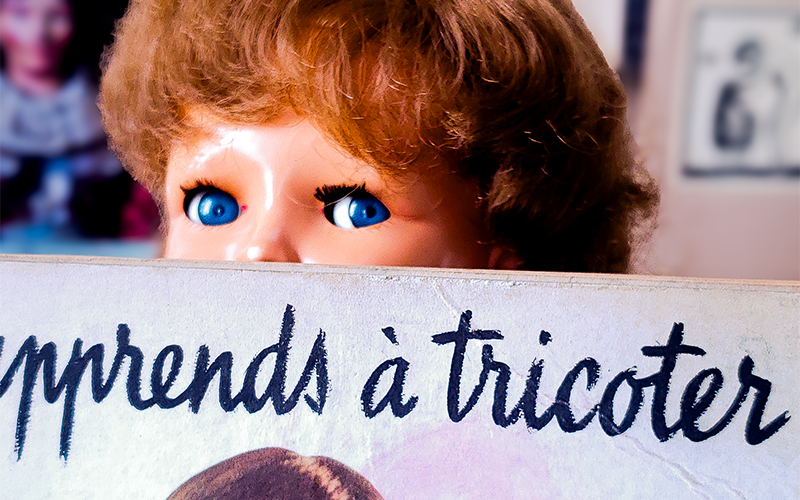

Dear friends,
Before all else, I thank you for the piles of supportive comments that followed last month’s letter. In a tough world, words of kindness are never to be taken for granted.
And I’m happy you didn’t mind reading about the vintage doll project for the holiday windows at Les Tricoteurs Volants because I have more to say about it today.
Although there are many more pressing knitting projects on the docket, the first outfit for Marianne* (the shop owner has decided that’s her name) keeps distracting me.
I thought I’d knock it out quickly in a couple of afternoons. The pattern, from the 1947 book J’apprends à tricoter pour habiller Primevere, ma poupée (I Learn to Knit to Dress Primrose, My Doll) was intended as a learning manual for a child. It’s all garter stitch, worked flat. A bunch of rectangles with minimal shaping.
While knitting the rectangles, I thought about the original audience for the book. Of course it is aimed explicitly at the jeune Française, the young French girl, who is pictured on the cover studiously turning out a doll scarf with needles as long as her forearms.
As soon as you open the cover, though, the authors address the other audience: les mamans. The moms.
In the Petite Préface, author Eliane Lamarque writes,
Knitting isn’t learned from books, like the alphabet, grammar, or the history of France. Little girls learn to knit on their own, so long as their mothers have the time and patience to show them how to begin. The speed at which they progress is therefore a matter of instruction. In dedicating this book to little French girls, we have simply wished to offer mothers and teachers a practical method for acquainting children with wool and needles.
There it is. The book is for the daughter, the I of I Learn to Knit, but mother’s participation will be required.
Her immediate participation. The first step of the first lesson is, “Ask maman to cast on ten stitches (you will learn later to do it yourself).” Again and again, throughout, maman’s intervention is required to lift the new knitter over this obstacle or that. Maman will cast on, maman will bind off, maman will do blah blah blah, go ask maman.
When the book was published, maman would have been part of a generation in which needlework, including knitting, was still part of the French public school curriculum for girls.** It was reasonable to assume that she would know how to knit. It was another thing to assume she enjoyed it, was any good at it, or was inclined to teach it.
We must hope that all three were true, because even for me the book is a real head-scratcher in many places–starting with the cast on.
I’ve been a professional knitter for almost two decades. I’ve spent many a cozy hour with learned colleagues, playing with cast-ons common and exotic, ancient and modern, foreign and domestic. I have never in my life run across the one in the book, a misbegotten spawn of the knitted and long tail methods. It is best worked with three hands, and the result after much swearing and sweating is remarkably ugly.
The patterns–which, please remember, are supposed to introduce children to the joys of knitting–are surprisingly fiddly. The ties for the bolero, for example. They’re worked in the same three-color stripe pattern as the skirt.
The color order for these stripes is such that you must either cut and re-join your working yarns after almost every stripe; or carry all three yarns along the entire right edge of each tie. If you want neat edges, you will have to weave in a lot of ends. But the book doesn’t tell you how to weave in ends. Go ask maman.
The book also doesn’t tell you how long the ties should be. It tells you to sew them on, one of many times sewing is required. Yet it never explains how to sew pieces together. Go ask maman.
Still, I pressed on as directed. I do love working from historic patterns, for better or worse, and I try to stay faithful. The results were…uh…
The drawstring waist? The weird, bulky bow?
Okay, listen. This would be fine in the milieu for which it was designed: the nursery. You wear this outfit to a tea party where the hostess is seven years old and all the other guests are stuffed animals? No problem.
For a boutique window in a world fashion capital? Hell no.
I have therefore decided to continue in the spirit of a different sort of maman. This maman likes knitting, and bought J’apprends à tricoter hoping it would encourage la petite Aurélie to do likewise. Aurélie did four raggedy rows of the first exercise before losing interest. The expensive new doll is sprawled across the settee, brioche crumbs in her hair, naked except for one sock. The yarn, needles, and book have been hidden under the cushion in the dog’s basket.
Maman picks up the lot and gets to work. She is only a few steps in before she begins to make changes. A drawstring waist? Non. Non. Not in this house, mon dieu.
So I, channeling this hypothetical mid-century French knitter, am using the original patterns only as a point of departure. There has been much ripping and remodeling.
First: Marianne’s bolero now closes with hooks hidden behind a little bow of more suitable proportions.
Second: Her skirt is now gathered into an actual waistband (lined with woven fabric so it won’t stretch). It buttons in the back.
And she has a pink beret, entirely my own improvisation, to top it all off.
Once I add a blouse, this will do nicely.*** It’s been a genuine pleasure to make, too. That’s good, because Marianne has a sister on the way from a doll dealer in Amsterdam.
I had no choice. Les Tricoteurs Volants has big windows.
Cordialement,
Franklin
*A name she shares with the female figure who serves as a symbol and embodiment of the French nation.
**Except in small villages, most French public elementary schools were segregated by gender until the 1960s. Ten years after the publication of J’apprends à tricoter, only 30% of French elementary schools included both boys and girls. Co-education was introduced at different times and places across the nation until it became compulsory in 1975.
***I promise to send you photos of Marianne in her finished ensemble when we unveil the holiday windows.


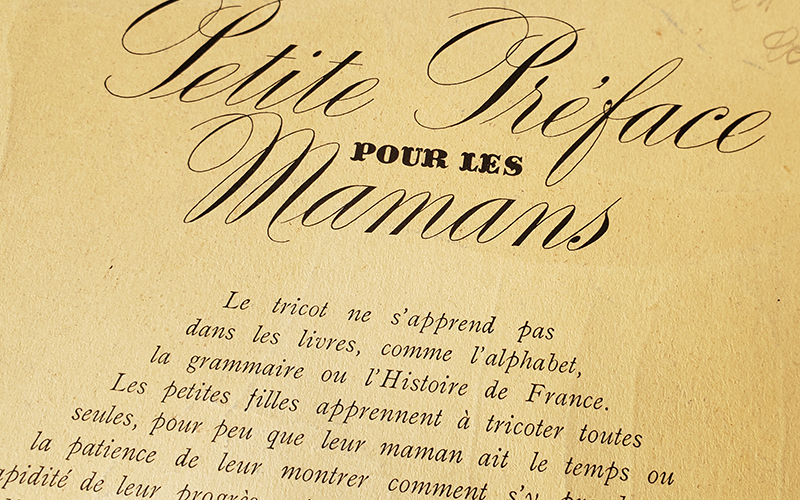
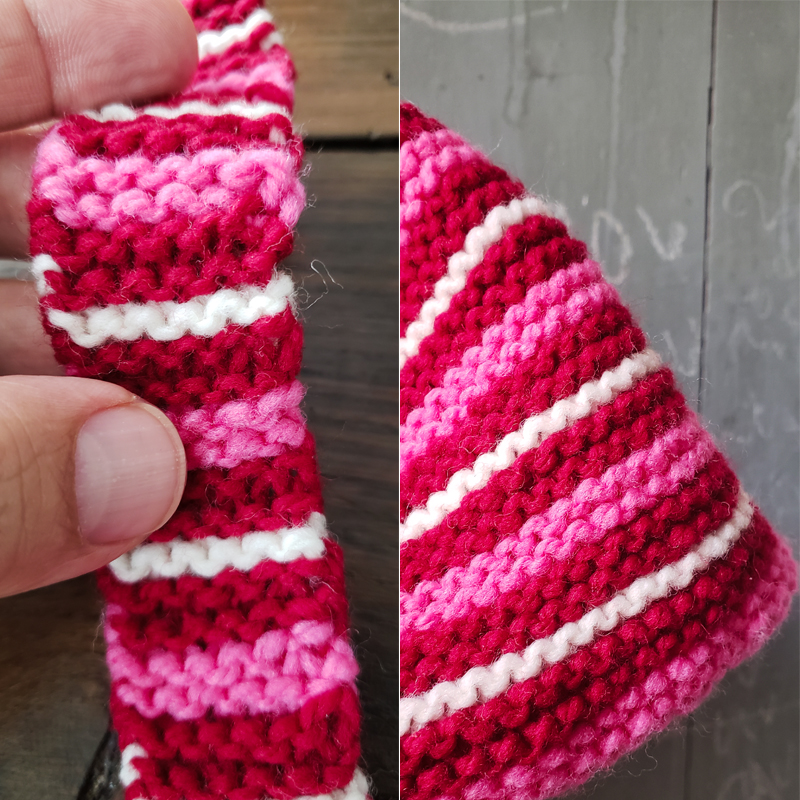
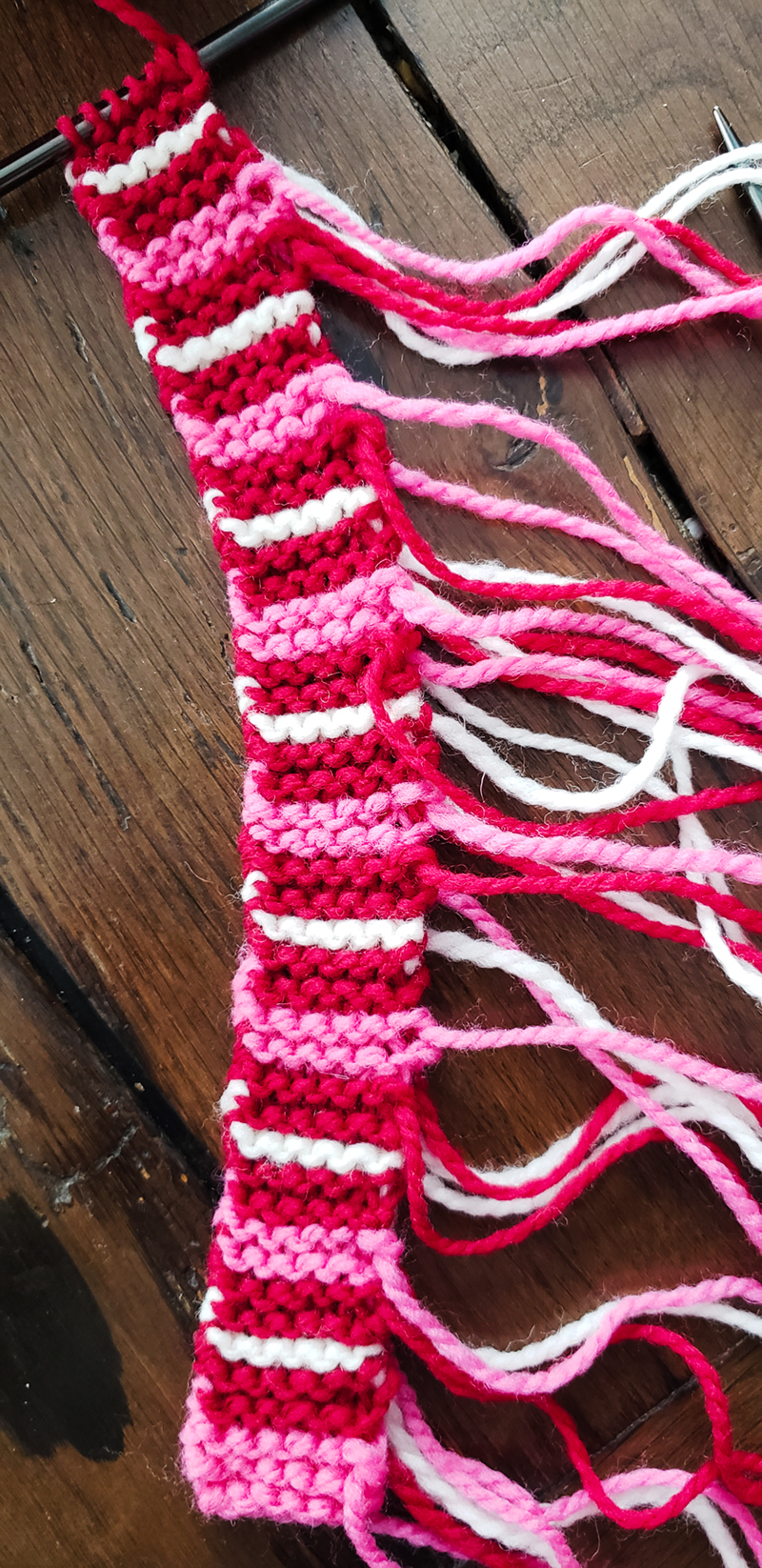
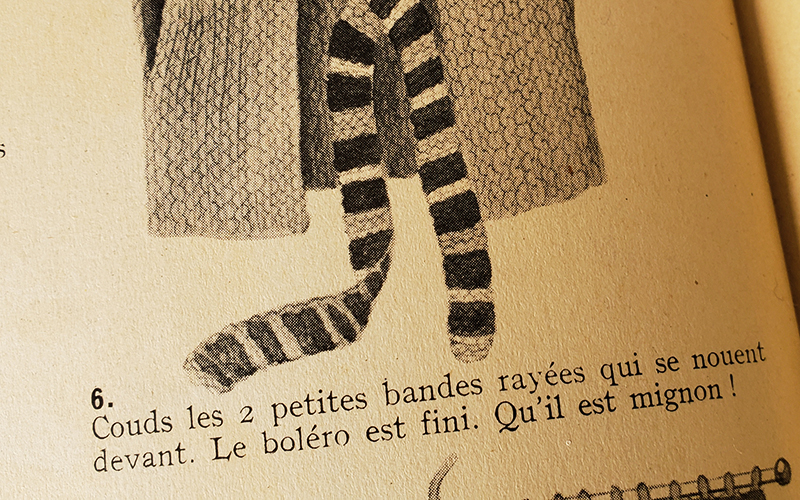

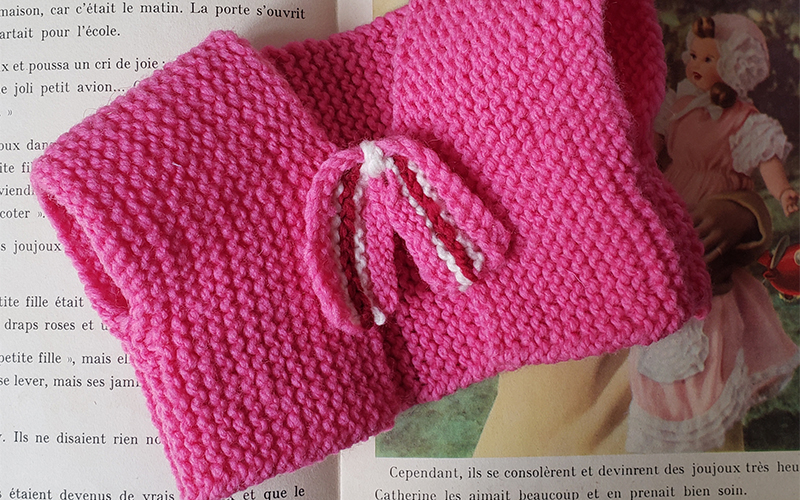

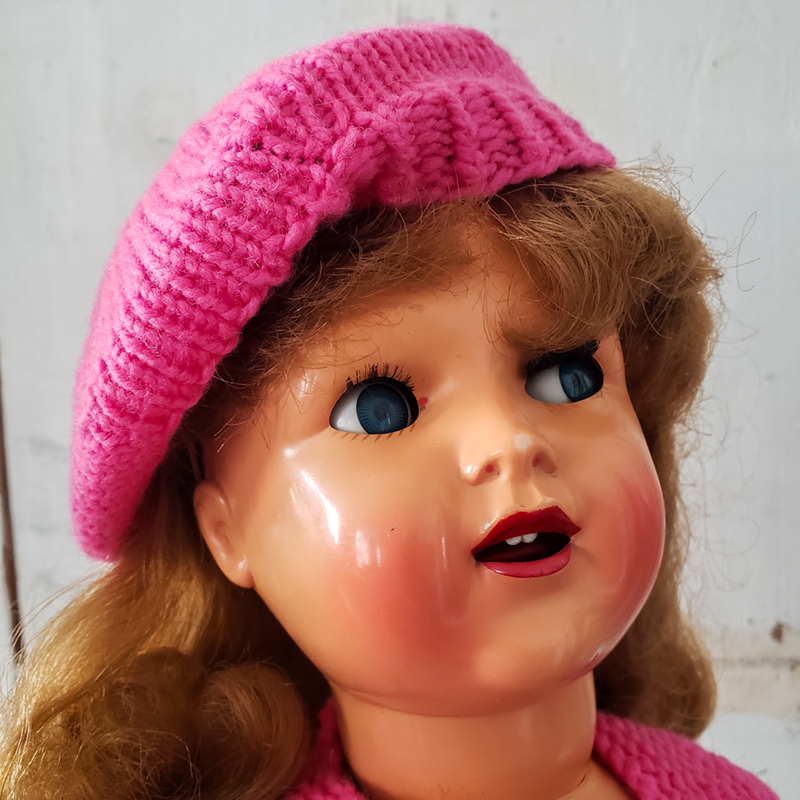

Thank goodness that you looked out for poor Marianne, Franklin! That ensemble was rather frightening in its original version. A little too Côte d’Azur and not suitable for a display window.
I’m looking forward to the completed window, as it is bringing back memories of the holiday toy displays in the department store of my childhood (J.L. Hudson’s, in Detroit).
I loved this post! As a French speaker, I could not wait to find this book to add it to my collection.
I got it! Ebay.fr had a copy that I quickly ordered. I am not sure if I will be knitting clothes for the dolls that I no longer have or if I will just cherish the book and wait to see photos of Franklin’s window!
Oh, I haven’t heard anyone speak of that store (Hudson’s) in decades! I remember childhood pre-Christmas trips there to see Santa & look at all the toys, especially the dolls. Sweet walk down Memory Lane—thanks!
This is so much fun!! Thank you for sharing, Franklin!!!
Franlklin–as always, witty and wise! J’aime the changes you made!
Forget getting Maman a glass of wine! Franklin, I hope someone delivered a libation of your choosing as you toiled to turn something rather horrid into a work of art!
I predict this window will be a huge hit, with grandmothers, mothers and daughters of all ages admiring the dolls, the outfits and sharing stories of their own dolls. It’s such a fundamental part of girlhood for so many women – what a great project. I can’t wait to see the finished result.
Ohh! That sounds like a brilliant oral history project! Sharing tales of long ago dolls, and the clothes making for them.
Oh my, what a way to make knitting no fun! Not all mamans like knitting for sure. My maman knit exactly one pale green sweater and matching hat with some intricate texture when she was pregnant with me. I know because I dressed my dolls with it. I learned to knit in a Quaker co-ed class in the 4th grade, a bright red hat being the result. Also got a “boyfriend” with whom we bombed enemy toy soldiers from his back porch with rocks. But we never knit together, tant pis.
Oh, Franklin, you have outdone yourself with this one! I chuckled several times. You are a source of delight in these difficult times. Thank you!
The beret is the very best! Good going.
I love her outfit and your interpretation is wonderful!
That tie is a bit much. All those color changes will make the first stitches stretched out and easy to accidentally drop. It’s like they want kids to hate knitting early so they’ll buy store-bought.
‘Give the saggy, fiddly mess to Mamam and ask her to weave in the ends. Bring her a nice glass of wine. When she starts swearing, bring her the entire bottle.’
I laughed out loud and some of Franklin’s commentary, and your response!
Thank you for a trip down Memory Lane. For me, the doll was Barbie, and the knitting was one of those circular looms. My Barbie wore several knit sheaths for several years.
You would be a lovely Maman. Your interpretation of Marianne’s outfit is tres jolie!
My grandma made dresses for my Barbies, with matching underwear (literal Granny panties) so Barbie wouldn’t catch cold. Ken, however, was just hanging loose under his assortment of pleather pants. I think Grandma was on to Ken and didn’t want to cramp his style at the Barbieland disco.
Enjoying this journey thoroughly…thanks for taking us along!!
I remember that in 1968 my school had to be mixte (boys and girls). But the directeur was horrified. So we had boys and girls BUT in different classrooms, and the récréations were alternate. HA! He thought he was clever.
Love the smiles and chuckles you bring to my morning coffee. Not to mention the delightful final interpretation of Marianne’s outfit.
Ah! The care, the details, the chic. The fabric lining so the waistband won’t get stretched out – made me smile. You instinctively know the goal, Franklin. Not really “doll clothes” but clothes. Doll-sized, perhaps today. But still with an eye to form and function. Very cool.
Your changes to the pattern are definitely beneficial to the entire design element. The clothing now has panache. What child could turn down such gorgeously constructed clothes for their petite doll?
Perhaps writing a leaflet with these beauties is in your future?
I love reading your posts
Oh what a joy!
If I were able to knit your first rendition, I would be quite proud.
Back to the cowls and hats.
I love the doll stories! And your interpretation is FAR better. Can‘t wait to see how she turns out!
The outfit you made for Marianne is so much cuter than the one the 1947 maman made!!!
I love your letters from Paris.
Thank-you!
You have vastly improved Marianne’s wardrobe.
I look forward to meeting her “sister”.
Perhaps because my own ‘maman’ needed to do my casting on and binding off (and perhaps did not demonstrate it well because at 9ish I never got the hang of it) I lost interest in knitting then like the girl in your example and it took me until a writer triggered my interest and it became my pandemic obsession almost 50 years later! Wise choices in the redesign!
It seems like Marianne was the permission slip for MORE DOLLS. Her outfit is the cutest. Bon chic bon genre!
Reality triumphed- a mama w/ brains and no piddly need to follow some lost ramblings of reduction to absurdity! Thanks for giving mama a boost! And the doll some fashion savvy.
What a delight to read, something simple made so hard long ago. You have triumphed. Look forward to the ensemble. Xxx
Oh, I love that this story continues!! Your changes are perfect (and much needed), and I’m looking forward to seeing more!
Well done! I can’t wait to see the new doll. My mother was a doll collector. It’s in my DNA now.
Ha ha. Cute project done cutely.
Last year I knit some dresses for some family Barbies, despite being a feminist and therefore philosophically against Barbie as something for girls to emulate. It was a bit of a challenge, but the project was successful. After seeing the works be just removed and the barbies left naked anyway, I moved on.
Definitely improvements were need and voila , you did it!
Franklin that is adorable! I So look forward to your posts.
As someone who has only very rarely knit a pattern as presented (your Anna Shawl was an exception), I applaud you taking such liberties and love the results. Looking forward to meeting the sister and seeing her outfits.
I am always excited when I see a post from Franklin! Can’t wait to see the Holiday window!
I know you promised but please please please, send photos. That skirt is fabulous!
How delightful! I used to use my gauge swatches to construct little jackets for my daughter’s threadbare teddy…because that was about all my gauge swatches were good for (lol, that has not changed). With maman’s taste in wool, Bearbear had quite the wardrobe: cashmere, suri, silk, oh my! Mostly maman could only be bothered to baste shoulders and side seams. A few times I may have added a ribbon closure, or even a spare button, at my daughter’s request. You’ve really elevated doll dressing!
Awww, my Teddy’s name was BearBear, too! He was passed down from kid to kid, so he became quite threadbare. (Threadbear?)
At 16 I bought myself my own bear…jointed, and named Tedward.
As always, Franklin is laugh-out-loud funny! Thank you ❤️
Oh, Franklin ~
Marianne’s ensemble is absolutely lovely!
A one-of-a kind Designer
delight ~
What wonderful stories she will tell while perched for all to see.
Jupe et boléro ravissants ! Dignes d’une vitrine parisienne…
Merci pour votre drôlerie, elle me met le sourire aux lèvres !
Je vous lis qu’en français mais votre esprit transparait !
Vivement les prochaines aventures de Marianne et Franklin. Caroline de Tours
Marianne will look tres chic in her new redesigned outfit!
Marianne and Aurelie are very lucky to have a maman such as you.
“Go ask maman.”
Thanks for another delightful letter.
Cheers.
I have got this knitting book in English, borrowed from my mother in law. Always been interested to see how the patterns would turn out!
Absolutely wonderful story. I’m still laughing! I had that doll but it was grandmama who gave me direction. I ended my career owning a wool shop for 27 years. Making doll’s clothes was never part of it!
I am glad you are feeling better and have the energy to resume your projects.
I look forward to seeing how the windows of the yarn store look for the holidays.
I recall in an earlier posting you related about your path to French citizenship that the government focused on integration… wanted you to become integrated into society – this sounds so impersonal, cut and dried. From all you have kindly shared it a suggests that the term (forgive spelling) entrainment -putting down roots better describes your journey.
Lovely to see Maman’s version, I love your adventures in France and design, knit on Franklin Habit!
Danish American here! Yes, I literally learned to knit at Mor’s knee, and my favorite knitting “pallette cleanser” is doll clothes (AG 18″). If you want to see extraordinary designs for the current US knitter look for Joan Duquette! Top down fair isle Icelandic look, cardigans, complete outfits. And for wonderful fun outfits just like the big girls wear, check out Nicky Epsteins designs. My mother used to knit for her vintage dolls from a 1950ish Danish booklet for years, and she also said out of necessity and common sense she adapted better ways to accomplish the same result, or better results. Franklin you’re talkin’ my language regarding the joy of knitting for our darling dolls. I could talk doll clothes knitting all day…. Fond regards xo, Gitte and my own auburn tressed Charlotte.
Marianne est très chic! How are her socks coming along?
Thank you, thank you, thank you! Very enjoyable post!
What a great project…I’m sure the installation will be tres superb!!!
There was a glitsch and I couldn’t access your column until later in the day (I wake up way early before the fix-it elves had a chance to get to work.). So glad to see more of the Adventures of Marianne. Your beret creation elevates all those so-called (clumsy) teaching “designs”. Poor little girls who were given those instructions! I was lucky. My clever “Maman” not only taught me easily to knit but did so as a right-hander teaching a left-hander. She was undaunted and that was what made the difference. As are you in your window dressing quest. Can’t wait to see the Cousin from Amsterdam, her new wardrobe and the final “tableau”!
I am of the 60’s generation (late) that had to learn all the crafts.
My mom was an excellent knitter but I don’t know if she taught me or school.
My brothers didn’t learn, tant pis indeed.
I can’t wait to see Marianne and her lovely outfit when I visit Paris in May. I hope she will still be in the window, maybe with her new sister. Memories of learning to knit for my doll…
My 60-year old French doll, Collette, and I so enjoyed this series.
Merci Franklin, tu es un génie.
I see that mamam is a clever knitter.Like my mother who taught me the basics of knitting.I like the beret the doll is wearing,and the simple top fastened anda plain bow
Really great blog post. Can’t wait to see the window display.
Thanks to Franklin I got to visit Les Tricoteurs Volants in June of this year. It’s a LOVELY store, and was air-conditioned. As it was very hot out the owner invited me to sit and knit in his comfortable chair by the window while I waited for my husband to return from his canal walk. A happy memory.
I may be an outlier but the first one looks just fine considering it represents a late 40s child’s project. The skirt is pretty decent! The modern edit is lovely and much better but I’m big on historical context for some of these things.
Oh, my grandma would have very similar comments about a pattern in that state! I absorbed sewing while playing on the floor of her sewing room as she worked, and knitting once I gained the attention span of adulthood (long tail cast on, with the 14 inch needles stabilized under the arm!)
I always thought of her more with sewing and the dozens of cross stitch and embroidery projects that adorned the halls in neat frames, but she did knit on occasion, most notably for my mom’s girlhood Francie doll, making sweaters with tiny sleeves the size of a finger! I can only hope she would be pleased with the tiny doll clothes I continue to make in my moonlighting job as a doll artist’s tailor
Really enjoyed this!
Omg! I had that book 60 years ago. And it was old then. My mother and all my aunties made Primrose clothes.
I was reading this with a bottle of LaCroix at my lips. I literally inhaled LaCroix up my nose when I scrolled down with my other hand and saw that photo! Absolutely hysterical. Thank you for making me laugh today!
Love it! Also, the colors are totally fun for a little girl. Take care — you rock.
I needed that laugh. Thank you as always
Franklin, your designer edits have elevated Marianne’s ensemble. So chic now! Looking forward to seeing the holiday windows.
Hilarious!! Thanks for sharing!
No demo of the cast on? Marianne is lucky to have Ton Ton Franklin looking out for her!
How great it was that my daughter Elizabeth was fortunate to meet you at your shop in Paris earlier this week. I share your postings with her to enjoy each time one arrives. Thanks for the photo of you with her. I can’t wait to hear all about you and your shop when she returns home.
How delightful! Can’t wait for Part 3 & pictures of Marianne & her sister in the holiday windows!
Oh Franklin, those holiday windows will be fantastic! I can’t wait to see the final result!
I had knitted two doll sweaters, and hats….my own sweater and, a poncho for grandma, hats for people and over 50 scarves all before eighth grade,(I was homeschooled). I made all of my sister’s and my own Sunday clothes and teddy’s and dolls. Repairs on many things, made my own sewing patterns… and made my Mom things as well. I made quilts, basically everything. I could read patterns when I had them but I didn’t most times. I recycled everything. On birthdays and Christmas I received yarn and fabric, buttons and things. I am not very old at all and I am thankful for these skills.
When I was a kid, I had two ( naked – gasp! ) trolls, and a naked teddy bear. I’m not sure if it was my Mom, or myself who was bothered by this. My other stuffed animals had no need for clothes. But my Mom crocheted a tiny sweater and headscarf for the larger troll, and made a tiny outfit with cotton scraps – bandeau top and skirt for the smaller troll. Two little rectangles with one snap each, with scraps from a dress she made me. And my bear, Smoky, had a crocheted vest, and socks, and a pair of baby shorts that was too small for any of my siblings.
I am thoroughly enjoying your adventures in attempting to use these old publications.
Is it any wonder the interest in the Needlearts waned around this time period?
Growing up in the 50s, Christmas store windows were a major attraction. In Baltimore, we would hop on the streetcar and head for Howard and Lexington Sts because the four major department store were clustered together there. These stores tried to outshine each other to present the best store window.
My grandmother also took me to Wanamaker’s in Philadelphia to see their store decorations, listen to the theater organ and see the dancing fountains. To get there we had to take the train for another exciting ride.
So glad this tradition is still available for other young girls to enjoy. Bless you for adding your talents to create this year’s window.
Bloody brilliant. So fun. Encore! Encore! (S’il vous plaît.)
Oh, Franklin, you had me laughing out loud while drinking my Saturday morning coffee . The prefect way to start the day!
I often wish my husband was interested in knitting; he is an engineer and his math skills are far superior to mine. Yours must also be stellar as evidenced by the lovely attire that Marianne is sporting after her unfortunate encounter with a quite outdated “look.” Thanks for keeping us updated. Your knitting adventures are always entertaining.
I was laughing so hard when I was reading this I had to stop a couple of times so I could wipe the tears from my eyes ! What a great way to start my day.
The new improved outfit looks like it will be awesome, lucky Marianne!
Your letters from Paris always make my day, thank you for sharing them.
Thank you “maman” Franklin
Luv your writing style–so easy to read and I feel like I ‘m with you in your journeys. Bravo!
Franklin, I do so love to read your musings. Always the first thing I turn to in any email that contains them. Thank you.
As always, so entertaining and enjoyable, producing both smiles and laughs. Also educational and a trip down the ‘lane of memory’. My maman, who liked to knit even if her patience was limited, grabbed my needles (the right one always firmly planted in my armpit!!) and did the cast ons and bind offs and probably more than her share of cables and of course dropped stitches and other mistakes. I love reading your letters, Franklin. Looking forward to seeing the final display in the shop window.
Marianne is set to be the best dressed doll! Though I do feel her original outfit that you knit should feature somewhere in her closet… I’m loving this adventure and so look forward to the amazing window this will be part of! Thank you for promising to share pictures
Love ❤️ the colours.
Love it! ❤️
This was something I would have loved. My mother did not knit, but she did just about every other kind of crochet tatting needle point and she was a bus driver when I was little her friends had older girls, and they were moving far away. They gave me all of the craft stuff I happily set in my living room in the big gold chair and learn to knit crochet and do all kinds of fun craft things my mother in the kitchen would come out to help me constantly, especially after the dog got her leg tangled around the yarn, jumped off my lap and pulled everything out again. My mother looked at the dirty little scrap, cut it off and stuck it in a plastic bag for later in case we needed the yarn we could wash it she said don’t worry about it starting over this time. You will do a much better job because you have learned how to do the stitches. I am 71 years old now and I appreciate all the lessons I learned from Ma’am Who learned from her mother and I made many mini baby doll clothes for my sister‘s dolls for her which she dearly loved and took a great big shoebox of my daddy’s and made a bed for her dolls and put all the clothes inside the bed and stitched only little knitted pillow and knitted blanket, so she could slide her dolls down in it. My sister never learned to do any knitting. My brother desperately wanted to learn to crochet and did very well unless someone came in the room at which time he stuffed it underneath the cushion so no one would see he was crocheting I told him that the early knitters and crochets were sailors who brought these interesting ways of making fabric back home with them and he should not be ashamed and then I made him a rubber band earring with a big gold loop on the end so he could be a pirate or a sailor
I loved this post! As a French speaker, I could not wait to find this book to add it to my collection.
I got it! Ebay.fr had a copy that I quickly ordered. I am not sure if I will be knitting clothes for the dolls that I no longer have or if I will just cherish the book and wait to see photos of Franklin’s window!
Love your persistence and the beautiful outcome. Lucky
doll!
I’m enjoying your letters. If you really want to go down a rabbit hole with little French girl outfits for dolls both knitted ,crochet and sewn Look for Bleuettte and Rosette Publications of Bleuette started in 1906 and finished in the 1960’s This news paper came out weekly and were started to help little girls be thrifty and learn to knit sew and embroider. There are FB pages for her and patterns on www The Bleu door . I look forward to your next letter. Happy knitting.
This whole story made me giggle!
I applaud your attempt to channel a 7-(perhaps?) year-old and appreciate your recognition of the heavy burden of sexism that pauvre mama had to endure. I’m looking forward to meeting Marianne’s sister.
Lisa
IG @knitpurrlgrr
My first thought after seeing Thais’ long, unstyled hair was to fashion her into a 1960’s Carnaby Street ‘bird’ wearing a Union Jack (or Christmas green?) minidress and Courreges boots. But she is not my doll! Can’t wait to see what you do with her outfit, Franklin! I’m sure it will be ten times more effective than anything I might dream up in my stuck-in-the-Sixties head. Can’t wait to see pictures of those windows! (And if they ask you for next year, don’t forget Courreges. Like I said. Stuck.)